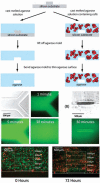Applications of microscale technologies for regenerative dentistry
- PMID: 19493883
- PMCID: PMC3317935
- DOI: 10.1177/0022034509334774
Applications of microscale technologies for regenerative dentistry
Abstract
While widespread advances in tissue engineering have occurred over the past decade, many challenges remain in the context of tissue engineering and regeneration of the tooth. For example, although tooth development is the result of repeated temporal and spatial interactions between cells of ectoderm and mesoderm origin, most current tooth engineering systems cannot recreate such developmental processes. In this regard, microscale approaches that spatially pattern and support the development of different cell types in close proximity can be used to regulate the cellular microenvironment and, as such, are promising approaches for tooth development. Microscale technologies also present alternatives to conventional tissue engineering approaches in terms of scaffolds and the ability to direct stem cells. Furthermore, microscale techniques can be used to miniaturize many in vitro techniques and to facilitate high-throughput experimentation. In this review, we discuss the emerging microscale technologies for the in vitro evaluation of dental cells, dental tissue engineering, and tooth regeneration.
Figures





Similar articles
-
Tooth Repair and Regeneration: Potential of Dental Stem Cells.Trends Mol Med. 2021 May;27(5):501-511. doi: 10.1016/j.molmed.2021.02.005. Epub 2021 Mar 26. Trends Mol Med. 2021. PMID: 33781688 Free PMC article. Review.
-
Tooth development: 2. Regenerating teeth in the laboratory.Dent Update. 2007 Jan-Feb;34(1):20-2, 25-6, 29. doi: 10.12968/denu.2007.34.1.20. Dent Update. 2007. PMID: 17348555
-
Innovative approaches to regenerate teeth by tissue engineering.Arch Oral Biol. 2014 Feb;59(2):158-66. doi: 10.1016/j.archoralbio.2013.11.005. Epub 2013 Nov 18. Arch Oral Biol. 2014. PMID: 24370187 Review.
-
Tooth Formation: Are the Hardest Tissues of Human Body Hard to Regenerate?Int J Mol Sci. 2020 Jun 4;21(11):4031. doi: 10.3390/ijms21114031. Int J Mol Sci. 2020. PMID: 32512908 Free PMC article. Review.
-
Stem Cells-based and Molecular-based Approaches in Regenerative Dentistry: A Topical Review.Curr Stem Cell Res Ther. 2019;14(7):607-616. doi: 10.2174/1574888X14666190626111154. Curr Stem Cell Res Ther. 2019. PMID: 31271121 Review.
Cited by
-
A dentin-derived hydrogel bioink for 3D bioprinting of cell laden scaffolds for regenerative dentistry.Biofabrication. 2018 Jan 10;10(2):024101. doi: 10.1088/1758-5090/aa9b4e. Biofabrication. 2018. PMID: 29320372 Free PMC article.
-
Integration of 3D Printed and Micropatterned Polycaprolactone Scaffolds for Guidance of Oriented Collagenous Tissue Formation In Vivo.Adv Healthc Mater. 2016 Mar;5(6):676-87. doi: 10.1002/adhm.201500758. Epub 2016 Jan 28. Adv Healthc Mater. 2016. PMID: 26820240 Free PMC article.
-
Hybrid PGS-PCL microfibrous scaffolds with improved mechanical and biological properties.J Tissue Eng Regen Med. 2011 Apr;5(4):283-91. doi: 10.1002/term.313. J Tissue Eng Regen Med. 2011. PMID: 20669260 Free PMC article.
-
Fabrication of bone-derived decellularized extracellular matrix/ceramic-based biocomposites and their osteo/odontogenic differentiation ability for dentin regeneration.Bioeng Transl Med. 2022 Apr 5;7(3):e10317. doi: 10.1002/btm2.10317. eCollection 2022 Sep. Bioeng Transl Med. 2022. PMID: 36176607 Free PMC article.
-
Strategies to design extrinsic stimuli-responsive dental polymers capable of autorepairing.JADA Found Sci. 2022;1:100013. doi: 10.1016/j.jfscie.2022.100013. Epub 2022 Sep 8. JADA Found Sci. 2022. PMID: 36721424 Free PMC article.
References
-
- Abe S, Yamaguchi S, Watanabe A, Hamada K, Amagasa T. (2008). Hard tissue regeneration capacity of apical pulp derived cells (APDCs) from human tooth with immature apex. Biochem Biophys Res Commun 371:90-93 - PubMed
-
- Anderson DG, Levenberg S, Langer R. (2004). Nanoliter-scale synthesis of arrayed biomaterials and application to human embryonic stem cells. Nat Biotechnol 22:863-866 - PubMed
-
- Anderson DG, Putnam D, Lavik EB, Mahmood TA, Langer R. (2005). Biomaterial microarrays: rapid, microscale screening of polymer-cell interaction. Biomaterials 26:4892-4897 - PubMed
-
- Avital I, Feraresso C, Aoki T, Hui T, Rozga J, Demetriou A, et al. (2002). Bone marrow-derived liver stem cell and mature hepatocyte engraftment in livers undergoing rejection. Surgery 132:384-390 - PubMed
-
- Ballini A, De Franza G, Cantore S, Papa F, Grano M, Mastrangelo F, et al. (2007). In vitro stem cell cultures from human dental pulp and periodontal ligament: new prospects in dentistry. Int J Immunopathol Pharmacol 20:9-16 - PubMed
Publication types
MeSH terms
Grants and funding
LinkOut - more resources
Full Text Sources
Other Literature Sources
Miscellaneous

